Assessing Reliability of Chinese Geotagged Social Media Data for Spatiotemporal Representation of Human Mobility
Abstract
:1. Introduction
2. Materials and Methods
2.1. Data Preprocessing
2.1.1. Inter-Regional Flows of Baidu Qianxi Map
2.1.2. Inter-Regional Flows Based on Geo-Tagged Weibo Tweets Data
2.1.3. COVID-19 and Geographic Boundary Data
2.2. Methods
3. Results
3.1. Preliminary Statistical Description
3.2. Multi-Dimenstional Correlation Test
3.2.1. Spatial Heterogeneity in Correlation
- (1)
- Province level
- (2)
- City level
3.2.2. Temporal Heterogeneity in Correlation
3.3. Case Study on COVID-19 Spread
4. Discussion
5. Conclusions
Author Contributions
Funding
Institutional Review Board Statement
Informed Consent Statement
Data Availability Statement
Conflicts of Interest
References
- Belyi, A.; Bojic, I.; Sobolevsky, S.; Sitko, I.; Hawelka, B.; Rudikova, L.; Kurbatski, A.; Ratti, C. Global multi-layer network of human mobility. Int. J. Geogr. Inf. Sci. 2017, 31, 1381–1402. [Google Scholar] [CrossRef] [PubMed]
- Chen, B.Y.; Wang, Y.; Wang, D.; Li, Q.; Lam, W.H.K.; Shaw, S.-L. Understanding the Impacts of Human Mobility on Accessibility Using Massive Mobile Phone Tracking Data. Ann. Am. Assoc. Geogr. 2018, 108, 1115–1133. [Google Scholar] [CrossRef]
- Zhen, F.; Qin, X.; Ye, X.; Sun, H.; Luosang, Z. Analyzing urban development patterns based on the flow analysis method. Cities 2019, 86, 178–197. [Google Scholar] [CrossRef]
- Derudder, B.; Taylor, P.J. Central flow theory: Comparative connectivities in the world-city network. Reg. Stud. 2018, 52, 1029–1040. [Google Scholar] [CrossRef]
- Zhao, K.; Tarkoma, S.; Liu, S.; Vo, H. Urban human mobility data mining: An overview. In Proceedings of the 2016 IEEE International Conference on Big Data (Big Data), Washington, DC, USA, 5–8 December 2016; pp. 1911–1920. [Google Scholar]
- Wang, Y.; Taylor, J.E. Coupling sentiment and human mobility in natural disasters: A Twitter-based study of the 2014 South Napa Earthquake. Nat. Hazards 2018, 92, 907–925. [Google Scholar] [CrossRef]
- Rizwan, M.; Wan, W.; Cervantes, O.; Gwiazdzinski, L. Using Location-Based Social Media Data to Observe Check-In Behavior and Gender Difference: Bringing Weibo Data into Play. ISPRS Int. J. Geo-Inf. 2018, 7, 196. [Google Scholar] [CrossRef] [Green Version]
- Xia, T.; Yang, K.; Wan, W.; Feng, X.; Yu, X. Delineating Urban Functional Areas with Sina Weibo Check-in Data: A Matching Time Series Distance Based LST-SVM Multi-classifier Method. J. Comput. 2019, 30, 13. [Google Scholar]
- Huang, Q.; Wong, D.W.S. Modeling and Visualizing Regular Human Mobility Patterns with Uncertainty: An Example Using Twitter Data. Ann. Assoc. Am. Geogr. 2015, 105, 1179–1197. [Google Scholar] [CrossRef]
- Liu, X.; Derudder, B.; Wang, M. Polycentric urban development in China: A multi-scale analysis. Environ. Plan. B Urban Anal. City Sci. 2017, 45, 953–972. [Google Scholar] [CrossRef]
- Ghermandi, A.; Sinclair, M. Passive crowdsourcing of social media in environmental research: A systematic map. Glob. Environ. Change 2019, 55, 36–47. [Google Scholar] [CrossRef]
- Su, X.; Spierings, B.; Dijst, M.; Tong, Z. Analysing trends in the spatio-temporal behaviour patterns of mainland Chinese tourists and residents in Hong Kong based on Weibo data. Curr. Issues Tour. 2020, 23, 1542–1558. [Google Scholar] [CrossRef]
- Stock, K. Mining location from social media: A systematic review. Comput. Environ. Urban Syst. 2018, 71, 209–240. [Google Scholar] [CrossRef]
- CENTER, S.W.D. Weibo User Development Report 2020. Available online: https://data.weibo.com/report/reportDetail?id=456 (accessed on 8 January 2021).
- Baidu. Baidu Qianxi. Available online: https://qianxi.baidu.com/ (accessed on 8 January 2021).
- Fisman, R.; Lin, H.; Sun, C.; Wang, Y.; Zhao, D. What motivates non-democratic leadership: Evidence from COVID-19 reopenings in China. J. Public Econ. 2021, 196, 104389. [Google Scholar] [CrossRef]
- Jiang, Y.; Deng, S.; Li, H.; Liu, Y. Predicting user personality with social interactions in Weibo. Aslib J. Inf. Manag. 2021, 73, 839–864. [Google Scholar] [CrossRef]
- Wang, Y.; Wu, P.; Liu, X.; Li, S.; Zhu, T.; Zhao, N. Subjective Well-Being of Chinese Sina Weibo Users in Residential Lockdown During the COVID-19 Pandemic: Machine Learning Analysis. J. Med. Internet Res. 2020, 22, e24775. [Google Scholar] [CrossRef] [PubMed]
- Tandoc, E.C.; Eng, N. Climate Change Communication on Facebook, Twitter, Sina Weibo, and Other Social Media Platforms; Oxford University Press: Oxford, UK, 2017. [Google Scholar] [CrossRef]
- Wu, K.; Wu, J.; Ding, W.; Tang, R. Extracting disaster information based on Sina Weibo in China: A case study of the 2019 Typhoon Lekima. Int. J. Disaster Risk Reduct. 2021, 60, 102304. [Google Scholar] [CrossRef]
- Miao, R.; Wang, Y.; Li, S. Analyzing Urban Spatial Patterns and Functional Zones Using Sina Weibo POI Data: A Case Study of Beijing. Sustainability 2021, 13, 647. [Google Scholar] [CrossRef]
- Ye, C.; Zhang, F.; Mu, L.; Gao, Y.; Liu, Y. Urban function recognition by integrating social media and street-level imagery. Environ. Plan. B Urban Anal. City Sci. 2020, 48, 1430–1444. [Google Scholar] [CrossRef]
- Hu, Q.; Bai, G.; Wang, S.; Ai, M. Extraction and monitoring approach of dynamic urban commercial area using check-in data from Weibo. Sustain. Cities Soc. 2019, 45, 508–521. [Google Scholar] [CrossRef]
- Cai, J.; Huang, B.; Song, Y. Using multi-source geospatial big data to identify the structure of polycentric cities. Remote Sens. Environ. 2017, 202, 210–221. [Google Scholar] [CrossRef]
- Zhen, F.; Cao, Y.; Qin, X.; Wang, B. Delineation of an urban agglomeration boundary based on Sina Weibo microblog ‘check-in’ data: A case study of the Yangtze River Delta. Cities 2017, 60, 180–191. [Google Scholar] [CrossRef]
- Zhang, W.; Derudder, B.; Wang, J.; Shen, W.; Witlox, F. Using Location-Based Social Media to Chart the Patterns of People Moving between Cities: The Case of Weibo-Users in the Yangtze River Delta. J. Urban Technol. 2016, 23, 91–111. [Google Scholar] [CrossRef]
- Qiao, M.; Wang, Y.; Wu, S.; Fu, X.; Gu, Y.; Dou, M. A realistic and multilevel measurement of citywide spatial patterns of economic segregation based on human activities. Cities 2021, 110, 103067. [Google Scholar] [CrossRef]
- Wang, F.; Guo, M.; Guo, X.; Niu, F. Research on the Hierarchical Spatial Structure of the Urban Agglomeration of the Yellow River Ji-Shaped Bend. Complexity 2021, 2021, 2293524. [Google Scholar] [CrossRef]
- Wei, S.; Wang, L. Examining the population flow network in China and its implications for epidemic control based on Baidu migration data. Humanit. Soc. Sci. Commun. 2020, 7, 145. [Google Scholar] [CrossRef]
- Lu, D.; Xiao, W.; Xu, G.; Ha, L.; Yang, D. Spatiotemporal patterns and influencing factors of human migration networks in China during COVID-19. Geogr. Sustain. 2021, 2, 264–274. [Google Scholar] [CrossRef]
- Chen, Z.; Gong, Z.; Yang, S.; Ma, Q.; Kan, C. Impact of extreme weather events on urban human flow: A perspective from location-based service data. Comput. Environ. Urban Syst. 2020, 83, 101520. [Google Scholar] [CrossRef]
- Liu, L.; Hu, T.; Bao, S.; Wu, H.; Peng, Z.; Wang, R. The Spatiotemporal Interaction Effect of COVID-19 Transmission in the United States. ISPRS Int. J. Geo-Inf. 2021, 10, 387. [Google Scholar] [CrossRef]
- Peng, Z.; Wang, R.; Liu, L.; Wu, H. Exploring Urban Spatial Features of COVID-19 Transmission in Wuhan Based on Social Media Data. ISPRS Int. J. Geo-Inf. 2020, 9, 402. [Google Scholar] [CrossRef]
- Chai, Y. Weibo User Historical Geotagged Posts Dataset, 6th ed.; Harvard Dataverse: Cambridge, MA, USA, 2021. [Google Scholar] [CrossRef]
- Hu, T.; Guan, W.W.; Zhu, X.; Shao, Y.; Liu, L.; Du, J.; Liu, H.; Zhou, H.; Wang, J.; She, B.; et al. Building an Open Resources Repository for COVID-19 Research. Data Inf. Manag. 2020, 4, 130–147. [Google Scholar]
- Jurdak, R.; Zhao, K.; Liu, J.; AbouJaoude, M.; Cameron, M.; Newth, D. Understanding Human Mobility from Twitter. PLoS ONE 2015, 10, e0131469. [Google Scholar] [CrossRef]
- Spyratos, S.; Vespe, M.; Natale, F.; Weber, I.; Zagheni, E.; Rango, M. Quantifying international human mobility patterns using Facebook Network data. PLoS ONE 2019, 14, e0224134. [Google Scholar] [CrossRef] [Green Version]
- Yan, X.-Y.; Wang, W.-X.; Gao, Z.-Y.; Lai, Y.-C. Universal model of individual and population mobility on diverse spatial scales. Nat. Commun. 2017, 8, 1639. [Google Scholar] [CrossRef] [PubMed] [Green Version]
- Cui, Y.; Xie, X.; Liu, Y. Social media and mobility landscape: Uncovering spatial patterns of urban human mobility with multi source data. Front. Environ. Sci. Eng. 2018, 12, 7. [Google Scholar] [CrossRef] [Green Version]
- Noulas, A.; Scellato, S.; Lambiotte, R.; Pontil, M.; Mascolo, C. A Tale of Many Cities: Universal Patterns in Human Urban Mobility. PLoS ONE 2012, 7, e37027. [Google Scholar] [CrossRef]
- Sekara, V.; Stopczynski, A.; Lehmann, S. Fundamental structures of dynamic social networks. Proc. Natl. Acad. Sci. USA 2016, 113, 9977. [Google Scholar] [CrossRef] [PubMed] [Green Version]
- Bai, L.; Lu, H.; Hu, H.; Smith, M.K.; Harripersaud, K.; Lipkova, V.; Wen, Y.; Guo, X.; Peng, W.; Liu, C.; et al. Evaluation of work resumption strategies after COVID-19 reopening in the Chinese city of Shenzhen: A mathematical modeling study. Public Health 2021, 193, 17–22. [Google Scholar] [CrossRef]
- Ye, X.; Li, S.; Peng, Q. Measuring interaction among cities in China: A geographical awareness approach with social media data. Cities 2021, 109, 103041. [Google Scholar] [CrossRef]
- Terroso-Sáenz, F.; Muñoz, A. Nation-wide human mobility prediction based on graph neural networks. Appl. Intell. 2021, 1–17. [Google Scholar] [CrossRef]



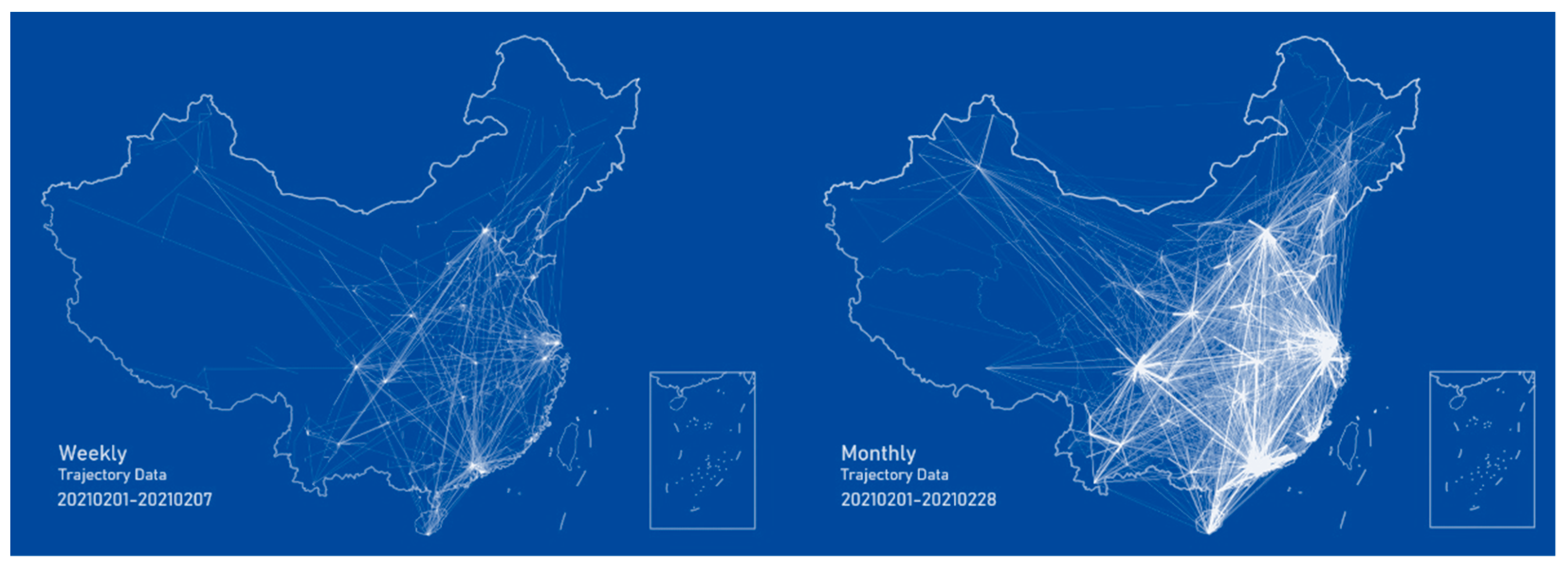





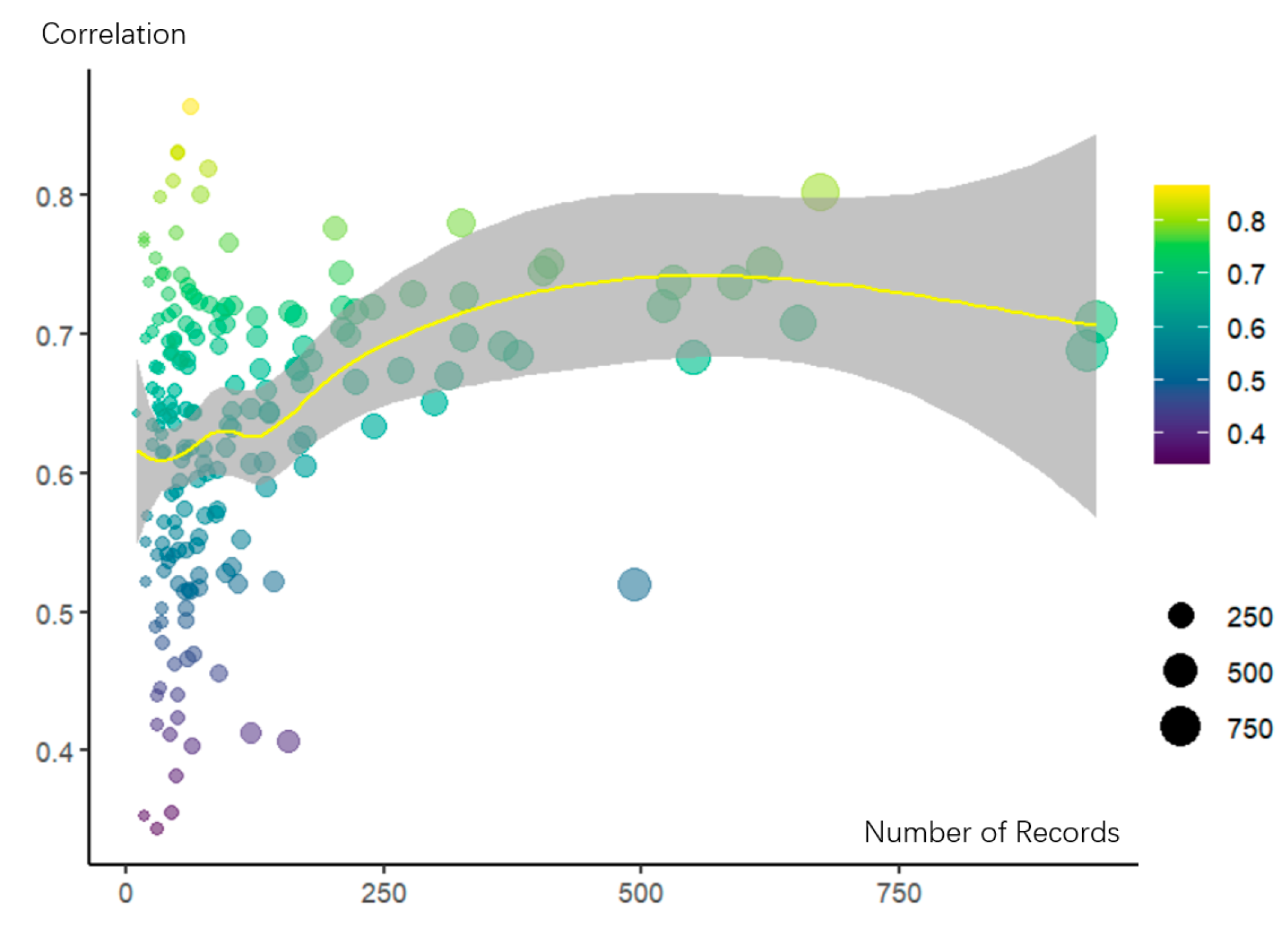

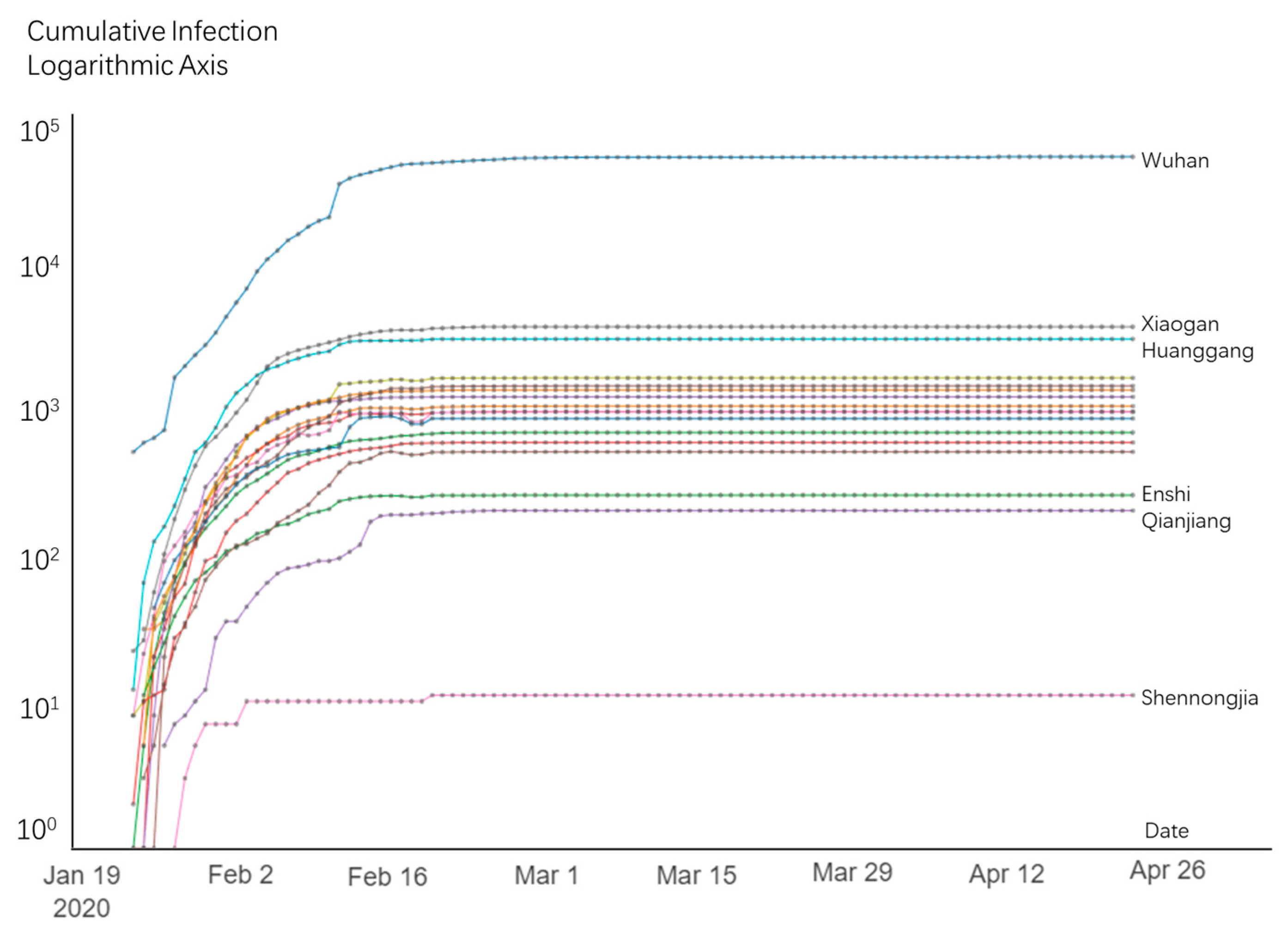
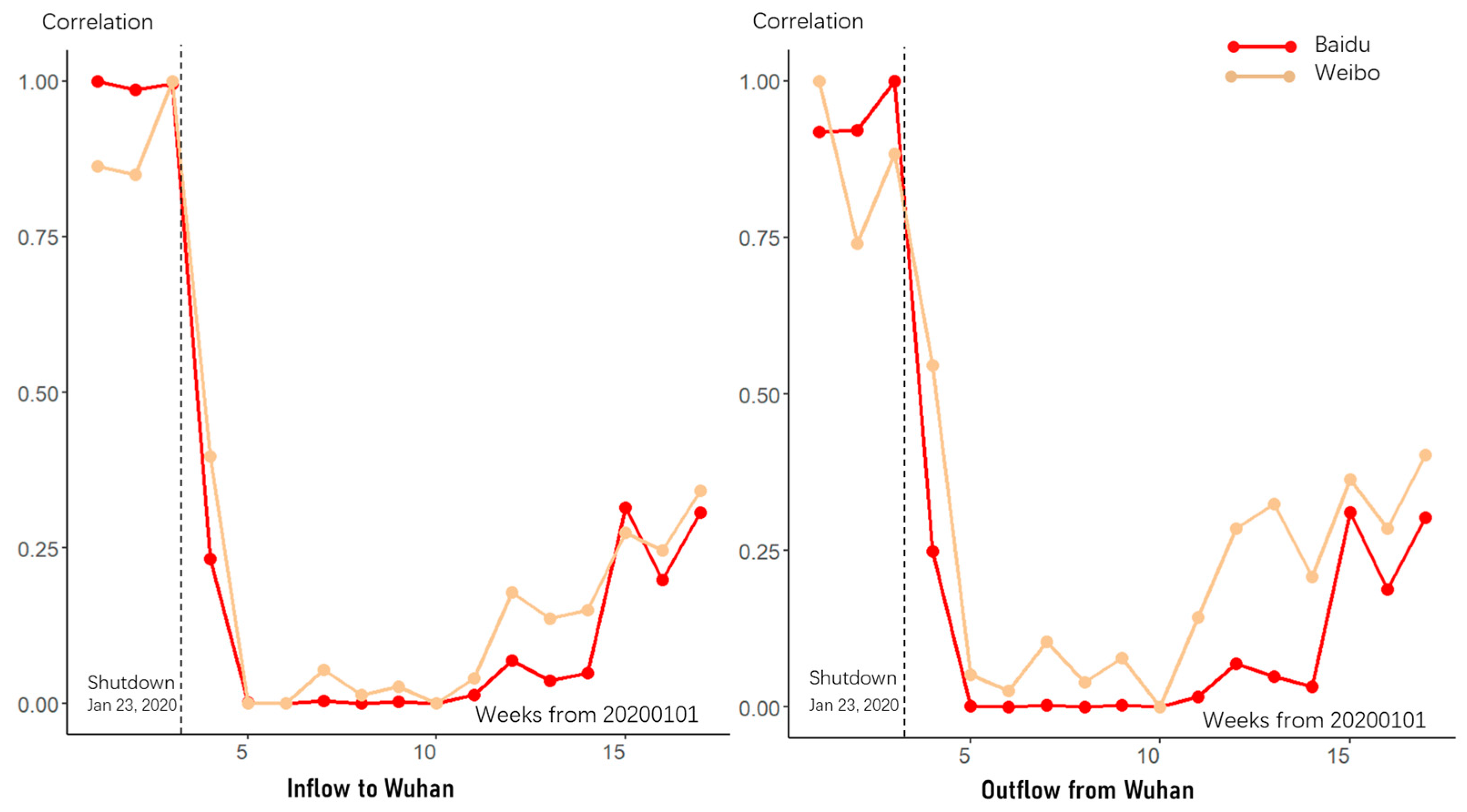
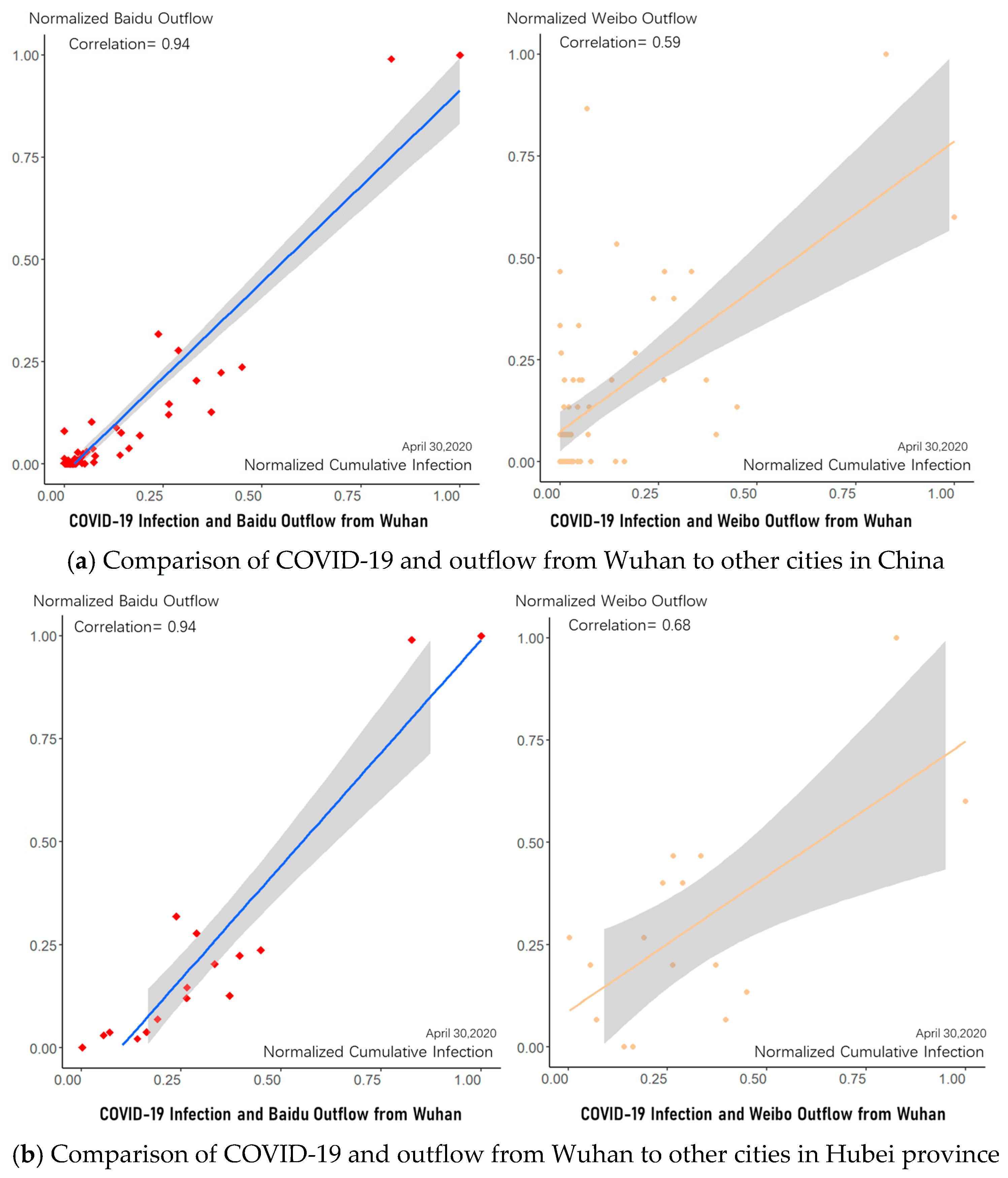
| Data Source | Geographic Units | Daily 1 April 2021 | Weekly 1–7 April 2021 | Monthly 1–30 April 2021 | Total | |||
|---|---|---|---|---|---|---|---|---|
| Records | % | Records | % | Records | % | |||
| Province | 20 | 1.84 | 399 | 36.64 | 824 | 75.67 | 33 × 33 = 1089 | |
| City | 34 | 0.01 | 1599 | 1.18 | 6332 | 4.68 | 368 × 368 = 135,424 | |
| Baidu | Province | 975 | 89.53 | 1007 | 92.47 | 1012 | 92.93 | 33 × 33 = 1089 |
| City | 35,570 | 26.27 | 55,275 | 40.82 | 72,450 | 53.50 | 368 × 368 = 135,424 | |
| Baidu | ||||||||
|---|---|---|---|---|---|---|---|---|
| Province | City | Province | City | |||||
| Monthly | Weekly | Monthly | Weekly | Monthly | Weekly | Monthly | Weekly | |
| Min | 0.000 | 0.000 | 0.000 | 0.000 | 1 | 1 | 1 | 1 |
| Max | 139.968 | 45.933 | 62.978 | 16.663 | 364 | 68 | 170 | 36 |
| Mean | 4.746 | 1.874 | 1.174 | 0.672 | 13.019 | 2.791 | 3.042 | 1.573 |
| Std. | 10.986 | 3.608 | 3.077 | 1.331 | 25.182 | 4.028 | 6.601 | 1.611 |
| Monthly | Weekly | ||||||||
|---|---|---|---|---|---|---|---|---|---|
| Min | Max | Mean | SD | Min | Max | Mean | SD | ||
| Count | Inflow | 0.427 | 0.942 | 0.772 | 0.119 | 0.140 | 0.852 | 0.553 | 0.182 |
| Outflow | 0.461 | 0.956 | 0.753 | 0.126 | 0.259 | 0.836 | 0.555 | 0.163 | |
| Rank | Inflow | 0.529 | 0.844 | 0.754 | 0.080 | 0.245 | 0.723 | 0.507 | 0.120 |
| Outflow | 0.555 | 0.844 | 0.754 | 0.082 | 0.378 | 0.721 | 0.513 | 0.078 | |
| Monthly | Weekly | ||||||||
|---|---|---|---|---|---|---|---|---|---|
| Min | Max | Mean | SD | Min | Max | Mean | SD | ||
| Count | Inflow | 0.269 | 0.991 | 0.726 | 0.162 | 0.143 | 0.864 | 0.504 | 0.167 |
| Outflow | 0.305 | 0.996 | 0.722 | 0.164 | 0.139 | 0.865 | 0.486 | 0.152 | |
| Rank | Inflow | 0.251 | 0.865 | 0.616 | 0.111 | 0.191 | 0.775 | 0.477 | 0.139 |
| Outflow | 0.250 | 0.802 | 0.624 | 0.097 | 0.209 | 0.732 | 0.474 | 0.119 | |
| Monthly | Weekly | ||||||||
|---|---|---|---|---|---|---|---|---|---|
| Min | Max | Mean | SD | Min | Max | Mean | SD | ||
| Count | Province | 0.712 | 0.793 | 0.768 | 0.032 | 0.322 | 0.807 | 0.632 | 0.133 |
| City | 0.626 | 0.721 | 0.668 | 0.034 | 0.352 | 0.637 | 0.531 | 0.078 | |
| Rank | Province | 0.699 | 0.843 | 0.778 | 0.056 | 0.371 | 0.701 | 0.510 | 0.080 |
| City | 0.593 | 0.630 | 0.611 | 0.018 | 0.304 | 0.516 | 0.444 | 0.051 | |
| Correaltionn for Flow Count | Correaltionn for Flow Rank | |||||
|---|---|---|---|---|---|---|
| Baidu-COVID | Weibo-COVID | Baidu-Weibo | Baidu-COVID | Weibo-COVID | Baidu-Weibo | |
| China | 0.939 | 0.617 | 0.702 | 0.707 | 0.439 | 0.748 |
| Hubei | 0.941 | 0.679 | 0.812 | 0.868 | 0.417 | 0.586 |
Publisher’s Note: MDPI stays neutral with regard to jurisdictional claims in published maps and institutional affiliations. |
© 2022 by the authors. Licensee MDPI, Basel, Switzerland. This article is an open access article distributed under the terms and conditions of the Creative Commons Attribution (CC BY) license (https://creativecommons.org/licenses/by/4.0/).
Share and Cite
Liu, L.; Wang, R.; Guan, W.W.; Bao, S.; Yu, H.; Fu, X.; Liu, H. Assessing Reliability of Chinese Geotagged Social Media Data for Spatiotemporal Representation of Human Mobility. ISPRS Int. J. Geo-Inf. 2022, 11, 145. https://doi.org/10.3390/ijgi11020145
Liu L, Wang R, Guan WW, Bao S, Yu H, Fu X, Liu H. Assessing Reliability of Chinese Geotagged Social Media Data for Spatiotemporal Representation of Human Mobility. ISPRS International Journal of Geo-Information. 2022; 11(2):145. https://doi.org/10.3390/ijgi11020145
Chicago/Turabian StyleLiu, Lingbo, Ru Wang, Weihe Wendy Guan, Shuming Bao, Hanchen Yu, Xiaokang Fu, and Hongqiang Liu. 2022. "Assessing Reliability of Chinese Geotagged Social Media Data for Spatiotemporal Representation of Human Mobility" ISPRS International Journal of Geo-Information 11, no. 2: 145. https://doi.org/10.3390/ijgi11020145
APA StyleLiu, L., Wang, R., Guan, W. W., Bao, S., Yu, H., Fu, X., & Liu, H. (2022). Assessing Reliability of Chinese Geotagged Social Media Data for Spatiotemporal Representation of Human Mobility. ISPRS International Journal of Geo-Information, 11(2), 145. https://doi.org/10.3390/ijgi11020145







